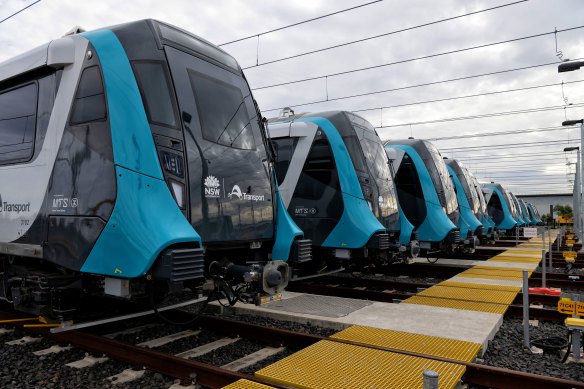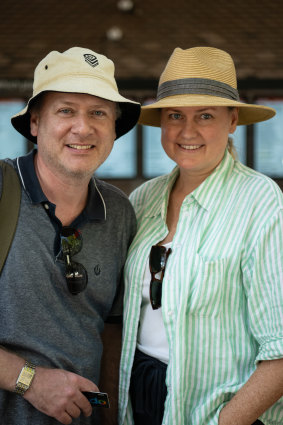This was published 6 months ago
Why the game has changed for Sydney’s new mega metro line
Sydney’s mega metro rail line under the heart of the city will have a new inter-peak period in the middle of the day, leading to driverless trains pulling into stations every five minutes in both directions between 10am and 3pm – twice as regular as those for an existing line.
Amid changed commuter travel patterns since the pandemic, metro trains will run every four minutes in both directions for three hours in the morning and four hours in the evening peaks, and initially every seven minutes in the inter-peak. At other times, they will operate every 10 minutes.
In a major change, the frequency of inter-peak services between 10am and 3pm will gradually increase within the first few months of the line’s planned opening on August 4 to a train every five minutes in both directions. The higher frequency of services has been set to match greater demand from commuters.
At present, a metro train runs every four minutes during peak periods on the Metro Northwest line between Tallawong in the city’s north and Chatswood, and every 10 minutes at other times on weekdays. They also operate every 10 minutes on weekends.
The $21.6 billion second stage of the city’s expanding driverless train network between Chatswood and Bankstown via the CBD and Sydenham has been known as Sydney Metro City and Southwest during seven years of construction.
It is an extension of the Metro Northwest line, which opened in 2019 at a cost of $7.3 billion. The entire line will be known as the M1 when the city-section from Chatswood to Sydenham opens on August 4.

Part of the 45-strong train fleet for Sydney’s extended metro rail line under the harbour and CBD.Credit: Nick Moir
Sydney Metro expects 37,600 commuters to use the extended line between Tallawong and Sydenham from 8am to 9am. That represents a 160 per cent increase on the 14,400 passengers who typically travel on the line from Tallawong to Chatswood during that period at present.
The agency said the ramp up of inter-peak services to a train every five minutes within the first few months of the extended line’s opening reflected expected travel patterns and demand.
Sydney Metro chief executive Peter Regan said patronage on the Metro Northwest line took a “big hit” like the rest of the city’s rail network during the pandemic, but was now well above pre-COVID levels.
“It is growing pretty strongly now. We’ll see a big jump when the next stage opens because you’ll then get that through connection [to the CBD],” he said.
Regan said patronage was growing the most during “non-traditional times” for travel on public transport such as the middle of the day and on weekends.
“People are clearly changing their trip patterns. And the whole transport network is still sort of bending down to the fact that people travel differently. There’s much less Monday to Friday, nine-to-five travel,” he said.

Edward Beesley and Fiona McEwan.Credit: Wolter Peeters
The city section of the new metro line comprises six underground stations, including at North Sydney, Barangaroo and Martin Place, as well as new platforms at Central and Sydenham.
The agency is forecasting more than 264,000 passenger trips between Tallawong and Sydenham each weekday after the extended line opens in early August. Trains will operate on the line from 4.08am to 1.20am Monday to Thursday; 4.08am-2.20am on Fridays and Saturdays; and 4.08am-11.50pm on Sundays.
Transport Minister Jo Haylen said she wanted public transport to be more than just a service that people used to get to and from work.
“A turn-up-and-go service like metro gives us a chance to start flattening the peak and begin making public transport the default option that people will want to use to do things like the shopping,” she said.
Alexandria residents Edward Beesley and Fiona McEwan, who have rented a property in the inner-city suburb for the past eight years, mostly use trains and buses to travel around Sydney because they do not own a car.
Beesley said the new metro would make it easier to get to the city’s north. “You might find it takes you to places you haven’t been before,” he said.
However, he is worried that businesses near the new Waterloo metro station have relocated to other suburbs because landlords have increased rents ahead of the line’s opening. “They have gotten greedy,” he said.
Start the day with a summary of the day’s most important and interesting stories, analysis and insights. Sign up for our Morning Edition newsletter.